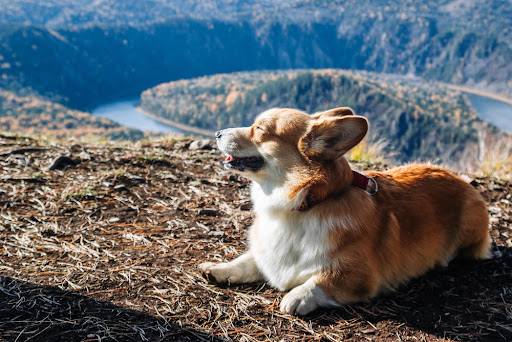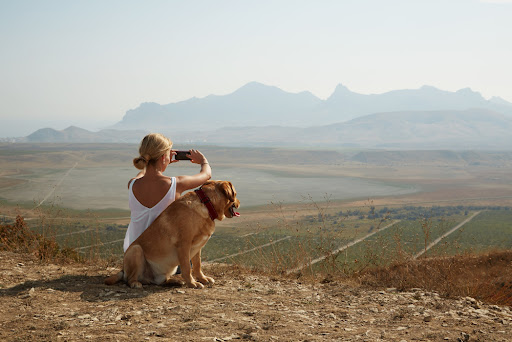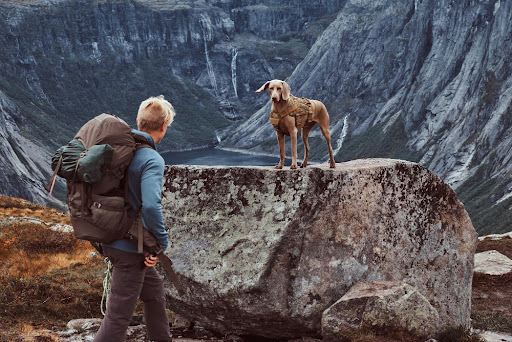Can Dogs Get Altitude Sickness?
Posted by Volhard Dog Nutrition on May 26th 2023
Spring has always been a time of great joy and excitement for Lydia and Denali, her lovely Aussie Shepherd. For years now, they've been wandering in the forest near their house on winding paths and secret trails, always ready to reconnect with Mother Natu.
This year, Lydia decided to step it up a notch and plan a week-long trip to the mountains — nothing more exciting for her and her four-legged partner! But the one thing she forgot to account for in advance was the increase in altitude. As they approached the mountaintop, Denali started experiencing shortness of breath, nausea, and increased heart rate. The cause? Altitude sickness.
What is Altitude Sickness in Dogs?
Pets are also susceptible to various altitude increase symptoms, many of which we, humans, also experience. If allowed to advance, altitude sickness in pets can lead to a potentially deadly buildup of fluid in the lungs and brain, especially if the pet is engaging in prolonged physical activity. Like in humans, high altitude sickness occurs when the concentration of oxygen molecules in the air (i.e., barometric pressure) is lower the higher you go in elevation. Most symptoms of altitude sickness in dogs occur at high altitudes (i.e., between 5,000 and 11,500 feet), becoming more severe at extreme altitudes (11,500 to about 18,000 feet).
Acute mountain sickness — or AMS — is unexpectedly common among the human population, with 1 in 2 people living at a lower altitude experiencing symptoms at an altitude above 10,000 feet.

Symptoms of Altitude Sickness in Dogs
Your dog's body will exhibit symptoms of altitude sickness as it works to compensate for the decreased oxygen levels. At first, you will notice vomiting or nausea, excessive panting or drooling, loss of appetite, increased heart rate, and pale gums. In addition, fluid accumulation in the lungs (i.e., high-altitude pulmonary edema) will make breathing harder and harder for your dog.
The symptoms will progress the longer you wait to take action, going as far as swelling of the face and limbs, bleeding from the nose, or even collapsing. Fortunately, these alarming symptoms only occur at high to extreme altitudes (i.e., over 8,000 feet above sea level), way higher than most areas in the US.
Preventing Altitude Sickness in Dogs
Safety must always be your priority when introducing your dog to higher elevations. Low-altitude pet owners should learn the signs of altitude sickness and pets and when to seek help.
If your dog starts showing any signs of altitude sickness, immediately decrease their physical activity levels and take them to an elevation below 1000 feet. Your dog requires veterinary care unless the symptoms improve at a lower elevation, as altitude sickness can become life-threatening.
It's All About Being Proactive
Preventing altitude sickness is all about being proactive. If you intend to take your dog on a hike to a higher altitude, it's always a good idea to have a plan in place to prevent the onset of this condition. Ensure that your dog is healthy enough for physical activity and that you've discussed any medical concerns with your veterinarian.
As a general rule, dogs with heart diseases or heart murmurs should not be taken on these types of hikes in the mountains. Likewise, senior dogs are more sensitive to the changes brought by higher altitudes.

Gradually Introduce Your Dog to a Higher Elevation
Choose a step-by-step approach when introducing your dog to elevations higher than usual, as the canine body needs time to adjust to the lower air pressure. Begin by taking short hikes at progressively higher elevations over the course of several weeks. Then, increase the elevation and distance accordingly as your dog becomes accustomed to the new circumstances. Over time, a healthy dog's body will adapt and utilize oxygen better!
Brachycephalic Breeds are Predisposed to Altitude Sickness
Brachycephalic dogs such as Boxers, Pugs, Pekinese, Bulldogs, Boston Terriers, and all dog breeds with breathing issues should be closely monitored in the mountains. They are already predisposed to breathing problems, which can be exacerbated at high altitude locations.
Help Your Dog Relieve the Discomfort Caused by Popping Ears
Just like in humans, the pressure in your dog's eardrums changes at high altitudes, resulting in the all-known "popping ears." Provide your dog with a toy to chew on at high elevations to help pop their ears accordingly.
Keep Your Dog Hydrated
Proper hydration is key for your dog to fare well at a high altitude. Every time you stop for a drink, your dog should drink water as well. Make sure you pack extra water for both you and your dog to stay hydrated at higher elevations.
Pack a Larger Meal for Your Dog
Your dog's body will burn extra energy to simultaneously cope with the physical activity and high elevation. So be sure to pack extra food for the journey. It's always best to arrive over-prepared and not need it than to be underprepared and not have it!
Pack a First Aid Kit for Potential Emergencies
Mountain adventures are no walk in the park, so pack a first aid kit in case of an emergency. We recommend that you take along a dog-carrying harness or an emergency canine carrier just in case your dog gets injured or becomes ill and needs to be carried off the mountain.

Dogs Experience Altitude Sickness, Just Like We Do!
The canine body will always respond to transitions from lower to higher altitudes like ours. It does take time to accustom oneself to the new elevation, during which time dog parents must closely monitor their dogs' health. Always put your pet's health first, so return to lower altitudes at any sign of severe altitude sickness symptoms. Also, choose a proactive approach to prevent altitude sickness from taking its toll on your dog's health. For more advice on dog nutrition, health, and training, make sure that you contact us and check out our blog!
Volhard Dog Nutrition and its expert nutritionists are now offering online consultations to help more dog parents discover why, what, and how to feed their dogs the healthiest of foods! Speaking to a Volhard nutritionist will help you understand the inseparable relationship between healthy food, a healthy body, and a healthy mind. If you're interested in contacting one of our Volhard nutritionists, don't hesitate to access our consultation page!

